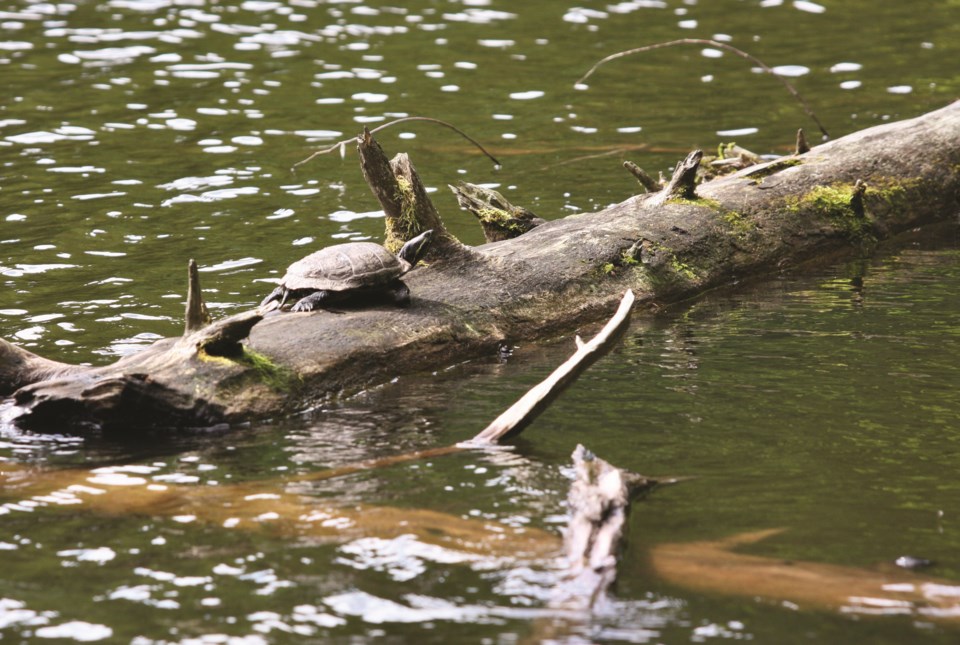As a Canadian science writer with a penchant for herpetology (the study of reptiles and amphibians), the most frequent question I get this time of year is, What do these critters do in winter? Good question and, being reasonably well-versed in Hibernation 101 (never mind that what reptiles do is technically not hibernation but a state of torpor called brumation), I fill them in. One thing I don’t often mention, however, is how studying this can help save some endangered species—like turtles. The other day, when someone asked about the brumal disposition of the (invasive) red-eared slider that lives in Alice Lake, north of Squamish, I said I didn’t know, but told them about the work of some Ontario friends.
One cold Boxing Day a few years back, then-graduate-students James Baxter-Gilbert and Julia Riley drove to a remote corner of Algonquin Park. Baxter-Gilbert donned an orange emergency flotation suit—the kind you find on fishing boats—attached a rope to himself, tied himself to a tree, and walked out on a frozen bay. Riley watched as he promptly fell through up to his waist. “You OK?” she called. “Yeah,” he replied, clawing his way back onto solid ice only to fall through again 10 steps later. The comic leitmotif repeated as Baxter-Gilbert alternately cut holes in the ice with an auger and his own weight.
When it comes to turtle conservation in the Great White North, most who research these familiar log-lounging icons of summer eventually find themselves scouting their subjects through a blanket of snow and ice. “You can’t say you’re a Canadian herpetologist until you’ve done winter work,” Riley—now Dr. Riley—once told me.
The outing—where they’d measured dissolved oxygen at overwintering sites—was no anomaly. Between them, the two species- at-risk researchers have worked on seven of Canada’s eight native freshwater turtle species. Each project involved tracking turtles via radio telemetry, and most included winter work. “We’re at the northern limits for most of these species, so time spent overwintering represents at least half their lives,” said Canada’s top turtle researcher, Dr. Jacqueline Litzgus of Sudbury’s Laurentian University. “What happens in summer with food and growth is important to fitness and breeding, but if you don’t survive winter, your fitness is zero.”
As such, turtles’ long annual nap (or not—in some cases) at the bottom of ponds, lakes and rivers has become a conservation focus. Because site choice is particular and vulnerability high during this time, impact to overwintering habitat can quickly override other considerations in the demise of a population. Such knowledge, however, is cold comfort if it can’t quickly be applied to conservation. And, unfortunately for a group that remains virtually unchanged from when it first appeared in the fossil record 220 million years ago, it’s a race against time.
All of Canada’s turtle species show significant declines, a problem exacerbated by government foot-dragging (while declines occur in hare-like leaps and bounds, protection moves at the speed of... well, a tortoise.) The problems start with basic biology: all turtle species are long-lived, slow growing, and late to sexual maturity (10-30 years); once there, however, they enjoy a long reproductive life (up to 50 years) and low adult mortality. Ecologically, such traits balance the high number of eggs and hatchings lost to predation over a lifetime.
While this evolutionary trade-off allowed turtles to survive cataclysmic events in Earth’s history, losses cannot quickly be replaced after sudden episodes of high adult mortality. Despite their geological resilience, turtles aren’t equipped to deal with anthropogenic threats—like vehicles encountered while crossing roads to and from nesting or overwintering sites, or overharvesting for the food and pet trades. Yet far from offering a respite, winter presents its own threats.
Overwintering turtles face three major challenges: freezing, predation, and acidosis (the toxic accumulation of metabolic lactic acid in tissues). Numerous studies demonstrate how turtles select overwintering sites that minimize these threats. Thermal stability is key. “A certain depth of water and a certain configuration that maintains temperatures is required—maybe a hole or a spring,” said Litzgus. “It’s very specific.”
Knowing the preferred sites for a species at risk presents a significant conservation opportunity. Construction companies, for example, often use winter for some types of work because it’s easier to drive heavy equipment across frozen soil and wetlands. This presents more of a hazard than just accidentally crushing a snoozing turtle. “Some species choose the coldest areas of stratified water, so the biggest threat becomes changes in hydrology,” noted Litzgus. “Any alterations to water flow will change the thermal profile—which in turn can increase risk of acidosis or predation.”
With good sites at a premium, turtles usually end up overwintering with many of their buddies. The importance of such communal gatherings to springtime mating is clear, however, with a large percentage of the breeding population present in one small area, population-level effects of destroying the site or its occupants can be disastrous.
Nevertheless, a lot has been discovered about what turtles are doing under the ice. Some (like painted turtles) can burrow into anoxic mud and breathe through their butts, others (like wood turtles) not so much. Some species (like the red-eared slider in Alice Lake) stay still for long periods, while others (like map turtles) appear to be comparatively active.
Figuring this out for each population means that the only thing between extirpation and conservation may be those like Baxter- Gilbert and Riley willing to brave the cold on turtles’ behalf—though it doesn’t always involve tying yourself to a tree.
Leslie Anthony is a biologist, writer and author of several popular books on environmental science.




